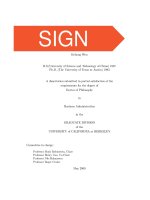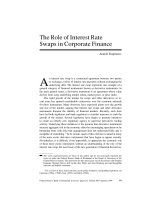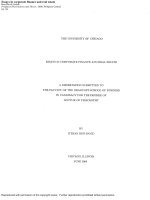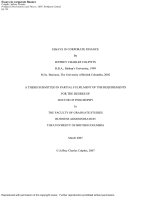Two essays on transparency in corporate finance Mergers and repurchases
Bạn đang xem bản rút gọn của tài liệu. Xem và tải ngay bản đầy đủ của tài liệu tại đây (1.15 MB, 192 trang )
THE FLORIDA STATE UNIVERSITY
COLLEGE OF BUSINESS
TWO ESSAYS ON TRANSPARENCY IN CORPORATE FINANCE:
MERGERS AND REPURCHASES
By
Yung Ling Lo
A Dissertation submitted to the
Department of Finance
in partial fulfillment of the
requirements for the degree of
Doctor of Philosophy
Degree Awarded:
Summer Semester, 2007
Copyright © 2007
Name
All Rights Reserved
UMI Number: 3282641
3282641
2007
Copyright 2007 by
Lo, Yung Ling
UMI Microform
Copyright
All rights reserved. This microform edition is protected against
unauthorized copying under Title 17, United States Code.
ProQuest Information and Learning Company
300 North Zeeb Road
P.O. Box 1346
Ann Arbor, MI 48106-1346
All rights reserved.
by ProQuest Information and Learning Company.
ii
The members of the Committee approve the dissertation of Yung Ling Lo defended on May16th,
2007.
.
James Ang
Professor Directing Dissertation
.
Bruce Billings
Outside Committee Member
.
William Christiansen
Committee Member
.
Ying-Mei Cheng
Committee Member
Approved:
.
William Christiansen, Chair, Finance Department
.
Caryn L. Beck-Dudley, Dean, College of Business
The Office of Graduate Studies has verified and approved the above named committee members.
iii
ACK NOWLEDGEMENTS
I appreciate all the suggestions and comments from my dissertation committee, which consists of
James Ang, William Christiansen, Bruce Billings, and Yingmei Cheng; from James Doran; and
from finance faculty members at Florida State University, University of New Hampshire,
Western Kentucky University, Central Michigan University, and Bowling Green University. I
also thank the Dissertation Research Grant Committee for the Dissertation Grant in 2006-2007.
iv
TABLE OF CONTENTS
LIST OF TABLES……………………………………………………………………………….v
LIST OG FIGURES………………………….…………………………………………………ix
ABSTRACT………………………………………………………………………………………x
ESSAY 1: ESSAY ON TRANSPARENCY IN THE MERGERS MARKET 1
INTRODUCTION 1
LITERATURE REVIEW 3
HYPOTHESES 5
METHODOLOGY 12
RESULTS 28
CONCLUSIONS 37
ESSAY TWO: ESSAY ON MARKET-TIMING ABILITY OF LOW TRANSPARENCY
FIRMS THROUGH STOCK REPURCHASE 38
INTRODUCTION 38
LITERNATURE REVIEW 39
HYPOTHESES 42
METHODOLOGY 55
RESULTS 71
CONCLUSIONS 82
APPENDIX A: PROBABILITY OF ANNOUNCING STOCK REPURCHASE 167
APPENDIX B: SIZE OF ANNOUNCED AND ACTUAL REPURCHASE 168
APPENDIX C: THE PROBABILITY OF CARRYING OUT REPURCHASE AND
TENDER OFFER 169
APPENDIX D: MARKET REACTION OF LT FIRMS VERSUS HT FIRMS 170
REFERENCES 171
BIOGRAPHICAL SKETCH 179
v
LIST OF TABLES
TABLE 1: CHARACTERISTICS OF THE TARGETS BASED ON TOTAL
TRANSPARENCY 84
TABLE 2: PROBIT ANALYSIS OF BIDDING 86
TABLE 3: UNIVARIATE ANALYSIS OF ACQUISITION PREMIUM 88
TABLE 4: MULTIVARIATE ANALYSIS ACQUISITION PREMIUM 89
TABLE 5: PROBABILITY OF STOCK PAYMENT 92
TABLE 6: UNIVARIATE ANALYSIS ON ACQUIRER’S MARKET REACTION 94
TABLE 7: OLS ANALYSIS ON ACQUIRER’S MARKET REACTION 95
TABLE 8: LONG-TERM BHARS OF THE MERGED FIRM 96
TABLE 9: LONG-TERM CARS OF THE MERGED FIRM 97
TABLE 10: CALENDAR-TIME APPROACH FACTOR ANALYSIS 98
TABLE 11: REGRESSION ANALYSIS OF POST-ACQUISITION LONG-TERM BUY-
AND-HOLD ABNORMAL RETURNS 99
TABLE 12: REGRESSION ANALYSIS OF POST-ACQUISITION LONG-TERM
CUMULATIVE ABNORMAL RETURNS 101
TABLE 13 MARKET REACTION OF ACQUIRERS AND LONG-TERM
PERFORMANCE OF MERGED FIRMS BASED ON THE NEGOTIATING POWER OF
THE TARGETS 104
vi
TABLE 14: CALENDAR-TIME APPROACH FACTOR ANALYSIS 105
TABLE 15: MARKET REACTION OF ACQUIRERS AFTER CONTROLLING FOR
CHARACTERISTICS OF THE TARGETS 107
TABLE 16: LONG-TERM PERFORMANCE AFTER CONTROLLING FOR
NEGOTIATING POWER, BOOK-TO-MARKET, AND SIZE OF THE TARGETS 108
TABLE 17: CHARACTERISTICS OF THE OPEN MARKET REPURCHASE FIRMS
BASED ON TOTAL TRANSPARENCY 109
TABLE 18: PROBABILITY OF OPEN MARKET REPURCHASE ANNOUNCEMENT
110
TABLE 19: MARKET REACTION OF OPEN MARKET REPURCHASE FIRMS 112
TABLE 20: SIZE OF THE REPURCHASE ANNOUNCEMENT 114
TABLE 21: PROBABILITY OF ACTUAL REPURCHASE RELATIVE TO
ANNOUNCED REPURCHASE 116
TABLE 22: SIZE OF THE ACTUAL REPURCHASE RELATIVE TO MARKET VALUE
OF EQUITY PRIOR TO ANNOUNCEMENT 119
TABLE 23: PROBABILITY OF ANNOUNCING TENDER OFFER VERSUS OPEN
MARKET REPURCHASE 122
TABLE 24: LONG-TERM CARS OF THE OPEN MARKET REPURCHASE FIRM 126
TABLE 25: LONG-TERM BHARS OF THE OPEN MARKET REPURCHASE FIRM 128
TABLE 26: CALENDAR-TIME APPROACH FACTOR ANALYSIS OF COMPLETED
OPEN MARKET REPURCHASE FIRMS 130
vii
TABLE 27: CALENDAR-TIME APPROACH FACTOR ANALYSIS OF CANCELLED
OPEN MARKET REPURCHASE FIRMS 132
TABLE 28: LONG-TERM PERFORMANCE OF OPEN MARKET REPURCHASE
FIRMS 133
TABLE 29: CHARACTERISTICS OF THE DUTCH AUCTION FIRMS BASED ON
TOTAL TRANSPARENCY 137
TABLE 30: PROBABILITY OF DUTCH AUCTION ANNOUNCEMENT 138
TABLE 31: MARKET REACTION OF DUTCH AUCTION FIRMS 139
TABLE 32: LONG-TERM CARS OF THE DUTCH AUCTION FIRM 140
TABLE 33: LONG-TERM BHARS OF THE DUTCH AUCTION FIRM 141
TABLE 34: CALENDAR-TIME APPROACH FACTOR ANALYSIS OF DUTCH
AUCTION FIRMS 142
TABLE 35: LONG-TERM PERFORMANCE OF DUTCH AUCTION FIRMS 143
BASED ON THREE-FACTOR MODEL RATS PROCEDURE 143
TABLE 36: CHARACTERISTICS OF THE FIXED-PRICE TENDER OFFER FIRMS
BASED ON TOTAL TRANSPARENCY 145
TABLE 37: PROBABILITY OF FIXED-PRICE TENDER OFFER ANNOUNCEMENT
146
TABLE 38: MARKET REACTION OF FIXED-PRICE TENDER OFFER FIRMS 148
TABLE 39: LONG-TERM CARS OF THE FIXED-PRICE TENDER OFFER FIRMS . 150
TABLE 40: LONG-TERM BHARS OF THE FIXED-PRICE TENDER OFFER FIRMS
152
viii
TABLE 41: CALENDAR-TIME APPROACH FACTOR ANALYSIS OF COMPLETED
FIXED-PRICE TENDER OFFER FIRMS 154
TABLE 42: CALENDAR-TIME APPROACH FACTOR ANALYSIS OF CANCELLED
FIXED-PRICE TENDER OFFER FIRMS 156
TABLE 43: LONG-TERM PERFORMANCE OF FIXED-PRICE TENDER FIRMS
BASED ON THREE-FACTOR MODEL RATS PROCEDURE 157
ix
LIST OF FIGURES
FIGURE 1: THE PROBABILITY OF RECEIVING OFFER 161
FIGURE 2: SUMMARY OF LOW TRANSPARENCY FIRMS 162
FIGURE 3: SUMMARY OF HIGH TRANSPARENCY FIRMS 163
FIGURE 4: PROBABILITY OF ANNOUNCING OPEN MARKET REPURCHASE 164
FIGURE 5: PROBABILITY OF ANNOUNCING DUTCH AUCTION 165
FIGURE 6: PROBABILITY OF ANNOUNCING FIXED-PRICE TENDER OFFER 166
x
ABSTRACT
In this dissertation, I examine whether low transparency (LT) firms have more market-
timing opportunities and are able to earn higher market-timing profits than high transparency
(HT) firms in two separate essays: 1) Essay on Transparency in Mergers Market and 2) Essay on
Market-Timing Ability of Low Transparency Firms through Stock Repurchase Activities.
LT firms have more information asymmetry problems (Diamond and Verrechia (1991)),
while information asymmetry can make stock valuation of LT firms more difficult
1
. As some
investors underestimate the value of the LT firms, others may overestimate the value of the LT
firms. Therefore, LT firms can have higher price dispersion and larger magnitude of mispricing.
In addition, the risk-averse investors will discount the stock of LT firms when the perceived
information risk increases. Therefore, the magnitudes of price dispersion and price discount are
both positively correlated with the level of information asymmetry problems. In essay one, I
examine whether the combination of price dispersion and price discount caused by higher
information asymmetry will allow LT firms to have more market-timing opportunities and to
demand higher acquisition premiums in the acquisition market. In essay two, I examine whether
the price discount and larger magnitude of mispricing provide LT firms with more market-timing
opportunities and higher profits through stock repurchase activities.
Based on my analysis in essay one, I find that LT firms in fact are more likely to receive
takeover offers during cold acquisition season. However, LT targets without enough negotiating
power are often acquired at discount, while LT targets with enough negotiating power can
demand higher acquisition premiums. Most importantly, the long-term performance indicates
that buying (selling) high negotiating power, high book-to-market, and large HT (LT) targets can
earn significant long-term profits. Therefore, while majority of existing studies have found HT
to be more advantageous, I find poor performers, proxied by book-to-market ratio, with enough
negotiating power can sell the firms at higher value than their true intrinsic value by remaining
less transparent.
Based on the analysis in essay two, LT firms are more likely to announce open market
repurchases and fixed-price tender offers than HT firms. In addition, LT firms are more likely to
1
Mensah et al. (2004) find high corporate disclosure can reduce analyst forecast dispersion.
xi
announce larger repurchase programs and to carry out the announced repurchase programs. This
indicates less immediate and less complete price adjustment at announcement for LT firms and
therefore more market-timing opportunities and profits for the LT firms. The long-term
performance analysis confirms the hypothesis that LT firms are more successful at timing the
repurchase of undervalued stock. Results based the open market repurchase sample are the
strongest of all.
1
ESSAY 1: ESSAY ON TRANSPARENCY IN THE MERGERS MARKET
INTRODUCTION
In this study, I classify targets based on their transparency levels. Low transparency (LT)
targets have lower disclosure and more information asymmetry problems, while high
transparency (HT) targets have higher disclosure, and therefore less information asymmetry
problems. High transparency and the corresponding reduction in information asymmetry are
generally acknowledged to be advantageous to the shareholders. However, the puzzle of why
some firms choose low transparency has not been resolved. In this study, I suggest low
transparency can be more beneficial to the shareholders in certain circumstances. The rationale
behind the basic idea is that low transparency can generate greater uncertainty and thus, higher
volatility, while higher volatility can create a potentially valuable timing option.
In this paper, I examine the value of the timing option of LT targets in the acquisition
market. More specifically, I investigate whether LT firms have more market-timing
opportunities and profits in the acquisition market. Low transparency can be advantageous if the
LT targets are able to use the information asymmetry problem to attract acquirers’ interests, to
receive a higher number of bids, and more importantly, to receive higher acquisition premiums.
In my study, I assume that the investors are risk averse and are aware of the information
asymmetry problem of the LT firms. As a result, investors will discount the price of LT targets
as a form of information compensation discount. Acquirers that mistake the price discount as a
bargain will be more likely to bid on LT targets. On the other hand, since HT firms have little or
no information asymmetry problem, their prices are more likely to be traded at or close to their
fair market value. Therefore, when the stock price of HT firms deviates from its intrinsic value,
the magnitude of mispricing will be smaller than that of LT firms. Consequently, such small
magnitude of mispricing predicts fewer market-timing opportunities and smaller market-timing
profits for HT firms as potential targets.
A common question may be raised here. Why would acquirers overpay during
acquisition? Based on the existing literature, acquirer managers may overpay during acquisition
when they are affected by hubris (Roll (1986)), empire-building mentality (Jensen (1986)), or
free cash flow problems during acquisition. If LT targets are able to use the information
2
asymmetry problem and larger scaled mispricing to take advantage of such acquirer managers,
by accepting offers that are higher than the true value and rejecting offers below the true value as
in optimal option exercise, they should be able to receive higher final acquisition premiums than
HT targets do. In addition, such findings will indicate that the information asymmetry problem
can facilitate wealth transfer from the acquirer shareholders to the target shareholders. More
importantly, the result will also explain why some managers choose to remain low transparency
when majority studies in the transparency literature have found high transparency to be more
advantageous.
This study provides several contributions. First, and most importantly, I examine if low
transparency does in fact provide managers with more market-timing opportunities and allow LT
targets to negotiate higher acquisition premiums. Second, I examine if LT firms are more likely
to receive stock as the primary method of payment. Based on optimal contract theory (Hansen
(1987)), when the target has information asymmetry problems, it is difficult for the acquirer to
accurately estimate the fair market value of the LT firm. This information asymmetry problem
predicts that the acquirers are more likely to experience unanticipated negative shocks post
acquisition. Therefore, it will be crucial for the acquirer to use stock payment when acquiring
LT targets, while the stock payment in this case serves as a risk-sharing tactic in the acquisition
market. It is important to note that the market-timing hypotheses in this study do not require or
assume acquirers to be irrational. However, when there is information asymmetry problems, the
less informed acquirers may make sub-optimal decisions by overpaying. Therefore, rational
acquirers that are aware of the information asymmetry problem will prefer stock payment when
acquiring targets at the estimated fair market value. Third, I examine if the market reacts
differently to the same payment method when the targets have different transparency levels.
Fourth, I examine if the merged firms consisting of LT targets do underperform in the long run
because LT targets are able to demand higher acquisition premiums.
In addition, while many may draw conclusions based on the public status of the targets,
since private targets in general have higher information asymmetry problems than HT targets do,
such assumption that private targets and LT targets always have the same firm characteristics
may be unrealistic. Therefore, to measure corporate transparency, I use more direct transparency
measures provided by the Association for Investment Management and Research (AIMR) report
in this study. To provide more robust results, I use the analyst forecast dispersion obtained from
3
the IBES
2
Summary Tapes, scaled by the price and absolute value of earnings, as additional
proxies of corporate transparency measures. By doing so, the dispersion measures allow me to
include mergers and acquisitions from January 1, 1980 to December 31, 2005 to ensure that the
results in this study are consistent through time. Furthermore, instead of only including
successful mergers as in many mergers and acquisitions studies, I include unsuccessful mergers
in the hypotheses as well when applicable.
LITERATURE REVIEW
In the corporate transparency literature, several researchers have identified the
advantages of high transparency while very few have acknowledged advantages of low
transparency. Even though existing studies in transparency have found advantages of higher
transparency to far outweigh the advantages of lower transparency, managerial choice of low
transparency in the corporate world indicates further examination of potential benefits of low
transparency is justified. Lang and Lundholm (1993) find that the level of transparency is
positively related to firm size and firm performance. Corporate transparency is also found to
have a positive relationship with profitability in the US market (Singhvi and Desai (1971)); with
responsiveness to earning (Price (1998)); and with stock performance, institutional ownership,
analyst following, and stock liquidity (Healy, Hutton, and Palepu (1999)). In addition, Welker
(1995) and Leuz and Verrecchia (2000) also find the increased disclosure can reduce bid-ask
spreads and increase share turnover. Amihud and Mendelsohn (1980), Callahan, Lee, and Yohn
(1997) suggest that increased liquidity can lower a firm’s cost of capital. Heflin, Shaw, and Wild
(2005) find that higher quality accounting disclosures, measured by total disclosure rating, can
increase market liquidity. Sengupta (1998) finds that a higher quality of disclosure is related to
lower effective interest costs in debt issuances. Botosan (1997) finds a negative (no) relation
between the cost of equity and disclosure when the firm has low (high) analyst following.
Furthermore, Verrecchia (2001) suggests that increasing disclosure can reduce investment
inefficiency by reducing information asymmetry and agency problems. Beatty and Ritter (1986))
believe that disclosure can reduce the ex-ante uncertainty and ex-ante underpricing. Durnev and
Kim (2002) find that firms with more profitable investment opportunities (proxied by higher Q),
2
Institutional Brokers Estimate System.
4
more concentrated ownership, and rely more on external financing tend to disclose more and
have better governance. Last but not least, Mensah et al. (2004) find that increase in disclosure
can reduce analyst forecast dispersion.
However, high transparency is not always more advantageous than low transparency.
Botosan and Plumlee (2002) find that while cost of equity is negatively related to annual
transparency rating, it is also positively related to timeliness of disclosure, such as quarterly
report disclosure rating. Therefore, timely disclosure can increase the cost of equity capital.
Bushee and Noe (1999) argue that increasing total disclosure can potentially reduce future stock
volatility when attracting long-term investors. However, when transient institutions trade on
short-term earnings news, the increase in volatility induced by transient investors will completely
offset the reduction in volatility brought by long-term investors. Therefore, timely disclosure
attracts transient investors and increases stock volatility. In addition, Verrecchia (1983), Healy,
Hutton, and Palepu (1999), Darrough and Stoughton (1990), and Wagenhofer (1990) argue that
disclosure can also be costly to a firm when it reveals information to competitors, which may
cause the firm to lose its competitive advantage or bargaining power. Therefore, based on the
existing literature in corporate transparency, the verdict on the pros and cons of greater corporate
transparency is not yet settled or definitive. This allows some firms to choose high transparency,
while other firms to choose low transparency for different reasons and advantages.
Mergers and acquisitions is a promising area in which to conduct empirical tests of
whether there is a rational basis for the choice of low transparency in certain situations.
Acquirers are known to misprice targets during acquisitions and make value-reducing decisions.
Roll (1986) argues that managers are often overconfident and over-optimistic. Acquirers tend to
overestimate the potential synergistic gains and are likely to overpay while making acquisitions.
Numerous studies have found consistent evidence indicating that acquirers often overpay during
acquisitions. Asquith, Bruner, and Mullins (1983) find that bidders on average lose. Varaiya
(1985) finds that when there are rival bidders, the successful bidders’ loss is significantly greater.
In addition, Loughran and Vijh (1997) find that acquirers in stock mergers underperform in the
long run. Consequently, if LT targets are able to utilize the advantage of the price discount and
price dispersion caused by information asymmetry, LT targets may be able to time the market
more successfully and to receive higher acquisition premiums, provided with enough negotiating
power to reject offers below their reservation value.
5
To summarize, the purpose of this study is to provide a more extensive and more direct
examination of LT targets to determine (1) if LT targets are more likely to receive bids or attract
acquirers’ interest, (2) if LT targets are more likely to receive higher acquisition premiums than
HT targets, (3) if acquirers are more likely to use stock as the primary payment method when
acquiring LT targets than when acquiring HT targets, (4) if the market reacts more negatively to
the acquirer’s merger announcement when the target has low transparency, (5) and most
importantly, if LT targets are in general more successful in market timing based on the long-term
performance of the merged firms.
HYPOTHESES
H1: Low transparency firms are more likely to become takeover targets than high
transparency firms.
In this analysis, I classify targets based on their transparency levels. Low transparency
(LT) targets have lower disclosure and more information asymmetry problems, while high
transparency (HT) targets have higher disclosure, and therefore less information asymmetry
problems. Since LT firms have more information asymmetry problems, risk-averse investors
will discount the stock price of LT firms as a form of information compensation discount
3
. This
price discount in this case can provide more incentive for acquirers to make acquisition offers on
LT firms. On the other hand, since HT firms have little or no information asymmetry problem,
the stock of HT firms is more likely to be traded at or close to the equilibrium. The equilibrium
pricing of HT targets predicts fewer ex ante profitable opportunities for acquirers. As a result,
acquirers that mistake price discount of LT targets as a bargain will be more likely to bid on LT
firms than on HT firms.
Acquirer managers can often make value-reducing decisions when they are affected by
hubris (Roll (1986)), empire-building mentality (Jensen (1986)), or free cash flow problems.
Acquirer managers who are affected by hubris (Roll (1986)) tend to over-estimate their ability,
3
While some may argue that it does not seem rational for target managers to choose low transparency and accept the
price discount caused by the information asymmetry problem, managers may still choose low transparency if the
estimated benefit of doing so is greater than the cost. Furthermore, the undervaluation may not always be crucial to
the managers except when the firm needs to raise external capital, when the insiders need to sell their share holdings,
or when the manager needs to exercise his or her stock options. Moreover, the undervaluation of the low
transparency firms may be acceptable when releasing proprietary information to the outside investor can reduce the
company’s competitive advantage.
6
overestimate the potential synergy in the merger, and overestimate the fair market value of the
firm; therefore, they are more likely to ignore the information risk and to overpay during
acquisition. On the other hand, acquirer managers who are affected by empire-building
mentality are more likely to make bad acquisition decisions not because they over-estimate their
ability, but because they tend to knowingly invest in negative NPV projects solely to expand the
size of the firm for their own fame and image, or simply because their compensation is tied to the
size of the firm. In addition, managers may also make bad decisions when the firms have excess
free cash flows. Excess cash flows can increase agency problems, provide managers with more
opportunities to waste the money, and cause managers to invest in negative NPV projects.
Therefore, acquirer managers who are affected by hubris, empire-building mentality, or free cash
flow problems are more likely to make bad decisions and to overpay during acquisitions. More
importantly, acquirers that mistake the information discount as a bargain will be more likely to
bid on LT targets and be willing to pay higher prices.
In my next hypothesis, I examine if LT targets are able to receive higher acquisition
premiums than HT targets under certain circumstances. Since LT targets have higher price
dispersion, the price dispersion predicts that LT targets should receive some offers at the lower
end of the price range as well as some at the higher end of the price range. Therefore, when the
LT target has higher price dispersion, the negotiating power of the target will play a key role on
the acquisition premium that the target will receive. The higher price dispersion of the LT
targets predicts that those targets with enough negotiating power to reject offers below their
reservation price should receive higher acquisition premium, while those without enough
negotiating power may be acquired at discount when there is no competition in the acquisition
market.
H2: If low transparency provides more market-timing opportunities and profits for LT
with negotiating power, low transparency targets are more likely to receive higher
acquisition premiums.
Assume that there are two identical targets, a LT target and a HT target, both have the
same intrinsic or fair market value of $100. Because the LT target has higher information
asymmetry problems, investors will discount the price of LT target to $90. Next, I introduce
price dispersion to the above basic model. Since information asymmetry will make accurate firm
7
valuation more difficult to outside investors, the LT target should have higher price dispersion
than the HT target. In other words, some investors may overestimate the value of the LT target
while others may underestimate the value of the LT target as a result of information asymmetry
problems. On the other hand, the HT firm has less or no information asymmetry problem.
Therefore, the HT target will have lower price dispersion. As a result, the price range of the two
targets is as the following:
LT $75-$125
HT $95-$105
For simplification purposes, assuming that acquirers believe that $10 synergy can be created by
acquiring either the LT or HT target. This means that the LT target may receive offers within the
$75 and $135 price range, while the HT will receive offers within the $95 and $115 price range.
Therefore, if the LT target has enough negotiating power to reject offers below its reservation
price and only accept offers above its reservation price, the price dispersion and information
asymmetry of the LT will allow it to demand higher acquisition premium from acquirers that are
willing to overpay.
In the analysis, since higher competition in the acquisition market will cause acquirer
managers to overpay, I also make sure to control for competition in the acquisition market when
examining the acquisition premium in this study. In addition, related mergers can occur when
the acquirer and the target are in the same industry. Since related mergers can create more
synergy and therefore higher acquisition premiums, an industry dummy is created in the analysis
to control for such potential synergistic gains. Furthermore, when the acquirer and the target are
in the same industry, whether the target has HT or LT, information asymmetry becomes less
important from the acquirer’s perspective. If reduced information asymmetry in related mergers
can reduce the market-timing ability of the LT target, acquirers should be less likely to overpay
in related mergers than in unrelated mergers when acquiring LT targets. To determine if
acquirers in related mergers are able to reduce the information asymmetry problem of LT targets
and therefore are less likely to overpay, I create an interaction term between the industry dummy
and the LT dummy in the analysis as well.
8
H3: Low transparency targets are more likely to receive stock payment during acquisition.
The importance of stock payment increases as the relative size between the target and the
acquirer increases.
When the target is too small to have a significant impact on the merged firm’s post-
merger operation, the acquirer may have no specific preference over the different payment
methods because the stake for the acquirer is small. Since the information asymmetry problem
of LT targets predicts a higher probability that acquirers may not discover all crucial information
during negotiation, acquirers that have to acquire LT targets at the full estimated fair market
value should be more likely to use stock payment as a risk-sharing tactic between the acquirer
shareholders and target shareholders. In this case, the stock payment is used to protect the
acquirer shareholders from the potential problems that may occur after the acquisition
4
. In
addition, as the relative size between the target and the acquirer increases, the stakes involved in
acquisition increase as well, from the acquirer’s perspective. Therefore, the risk-sharing function
of the stock payment becomes more important when the target has LT and when the target is
large enough to provide a significant impact on the merged firm. In addition, while the
acquirer’s undervalued stock may discourage the acquirer managers from using stock as the
primary method of payment, stock payment may still be preferred by the acquirers for as long as
the target value plus synergy is greater than the acquirer’s stock price per share times the number
of shares paid in acquisition, whether the stock is overvalued or undervalued. Lastly, the
importance of the risk-sharing function diminishes when the LT target is acquired at discount.
Therefore, the probability of stock payment should also decrease when acquirers are able to
acquire LT targets at discount, while everything else being equal.
On the other hand, since HT targets are more likely to be traded at or close to their fair
market value, acquirers are less likely to acquire HT targets at discount. In addition, since HT
targets have less information asymmetry problems, the risk-sharing function of stock payment
becomes less important when the target has high transparency. In this case, the method of
payment may simply be a function of the stock valuation of the acquirer. If the acquirer believes
that its stock is overvalued, the acquirer will choose stock as the primary method of payment.
4
While earnouts (partial payments to the former shareholders of the target contingent on the future performance of
the target under the control of the acquirer) may also be used as a risk-sharing tactic when acquiring low
transparency firms, earnouts are rarely used when acquiring public targets (Datar, Frankel, and Wolfson (1991) and
Cain, Denis, Denis (2005)).
9
Otherwise, the acquirer may prefer to use cash payment. Therefore, when the transparency level
of the target firm is not an issue, the acquirer should be more willing to use cash as the primary
method of payment when acquiring the target at the fair market value.
H4a: If low transparency targets can efficiently time the market, acquirers of low
transparency targets should receive worse market reaction for overpaying during
acquisition.
A target firm may be able to time the acquisition market when the target (a) knows its fair
market value and (b) has the ability to reject offers that are below the target’s reservation price
and accept those that are at or above the target’s reservation price. Theoretically, when the target
is acquired at discount or fair market value, the market is more likely to react positively to the
acquirer’s announcement
5
. On the other hand, if LT does allow the manager of LT firms to
demand higher acquisition premiums, the acquirers of LT target should receive worse market
reaction than the acquirers of HT targets. Since the price dispersion of LT targets predicts that
LT targets without enough negotiating power to reject offers below their reservation price are
likely to be acquired at discount, negotiating power of the target, more importantly of the LT
target, is used in the multivariate analysis
6
. In addition, since it may not be clear if the market
will react only to the raw unadjusted acquisition premium relative to the price prior to the
negotiation or the industry-adjusted premium, both unadjusted and adjusted premiums are
examined in the analysis. Furthermore, since acquirers in related mergers can mitigate the
information asymmetry problems of the LT targets, acquirers in related mergers less likely to
overpay. As a result, acquirers that acquire LT targets in related mergers should receive more
positive market reaction than acquirers that acquire LT targets in unrelated mergers.
H4b: When acquiring low transparency targets, acquirers that choose stock as the primary
method of payment will receive more positive market reaction at announcement than
acquirers that use cash as the primary method of payment.
5
When the target is acquired at the fair market value instead, the market should still react to the announcement
positively because of anticipated potential synergy that can be provided by the merger.
6
More specific details will be provided in the methodology section.
10
The choice of payment should have different impacts on the acquirer when the targets
have different transparency levels. When the target firm has more information asymmetry
problems, valuation of the target can be more difficult. As a result, optimal contract theory
predicts that using stock as the method of payment can alleviate the information disadvantage
that the acquirer faces when the target firm has more information asymmetry problems (Hansen
(1987)). Note that the importance of risk-sharing function also increases with the relative size of
the target. Since LT targets are more likely to have information asymmetry problems, which
indicates that it is more likely for the acquirers to face negative shocks after the negotiation or
after the merger is completed, acquirers will be better off to use stock as the primary method of
payment to provide the risk-sharing protection for the acquirer shareholders when acquiring LT
targets. Therefore, when acquiring LT targets, acquirers that choose stock as the primary
payment method will receive a more positive market reaction than those that choose cash as the
primary payment method. More importantly, the higher the proportion of stock payment used
when acquiring LT targets and the larger the relative size of the target, the more positive the
market reaction that the acquirer should experience, while everything else being equal. It is
important to note that while the market-timing hypotheses predict acquirers may make
suboptimal decisions by overpaying during acquisitions, the hypotheses do not assume or argue
acquirers to be irrational. Therefore, when acquirers are aware of the potential information
asymmetry problem, they should prefer stock payment over cash payment when acquiring targets
at the estimated fair market value.
On the other hand, this risk-sharing function becomes trivial when the acquirer is
acquiring a HT target. In addition, the risk-sharing function may also become trivial when the
acquirer and the target are in the same industry, since related mergers may reduce the
information asymmetry problem between the LT target and the acquirer. Therefore, in this case,
overvaluation signal
7
plays the dominant role when the role of risk-sharing function of stock
payment becomes insignificant. As a result, acquirers that choose stock as the primary payment
method when there are fewer information asymmetry problems will receive more negative
market reactions than those that choose cash payment, since stock payment in this case signals
that the stock of the acquirer is overvalued. Furthermore, the higher proportion of stock payment
7
Myers and Majluf (1984) believe that acquirers tend to issue stock when they believe that their stocks are
overvalued; therefore, the market tends to react to the overvaluation signal negatively.
11
used in acquisition and larger relative size of the target will trigger more negative market
reaction to the acquirer’s stock price.
Several studies have provided consistent support for this hypothesis. Chang (1998) finds
that acquirers that use stock to acquire private targets tend to experience positive market reaction
on average. Officer, Poulsen, and Stegemoller (2006) find that when the private target
experiences more information asymmetry problems, proxied by high intangible assets, the
acquirers receive a more positive market reaction when the primary method of payment is stock
rather than cash. In addition, Travlos (1987), and Houston and Rayngaert (1997) find that
acquirers that use stock to acquire public targets experience negative market reaction on average.
Therefore, if public firms in general have higher transparency than private firms, then the above
findings are consistent with this market reaction hypothesis.
H5: If low transparency targets with strong negotiating power are more successful at
market timing in the acquisition market, merged firms consist of low transparency targets
should underperform in the long run.
To determine if LT targets are more successful in market timing, I examine the long-term
performance of successful mergers, in addition to the acquisition premiums received by the LT
targets and the market reaction of the acquirers. If LT provides target firms with more market-
timing opportunities and allows target managers to demand higher acquisition premiums, the
acquirer of LT targets should experience worse market reaction. If the market reaction is
incomplete, merged firms consisting of LT targets should underperform the non-merged firms
and merged firms consisting of HT targets in the long run. This result will indicate wealth
transfer from the acquirer shareholders to the target shareholders of LT firms. However, if the
merged firms of LT targets outperform their counterparts in the long run, the result will indicate
that LT targets have weaker negotiating power than the acquirers in general; therefore, the
acquirers are able to take advantage of the price discount of LT targets while keeping the
synergistic gains to the acquirer shareholders. On the other hand, if the merged firms of LT
targets have zero abnormal performance in the long run, the result will indicate that LT still
allows the target managers to demand a fair acquisition premium, while the target shareholders
are able to capture the complete synergistic gains. Note that since overvalued acquirers are
12
likely to experience negative long-term performance because of price correction, book-to-market
of the acquirer is used as one of the control variables in the analysis.
In summary, if LT combined with strong negotiating power provide target managers
more market-timing opportunities and market-timing profits, those LT targets should be able to
not only receive more offers but also to negotiate higher acquisition premiums. As a result,
acquirers that overpay when acquiring those LT targets should receive worse market reaction
than acquirers that do not overpay. If the market reaction is incomplete at announcement, the
merged firm consisting of LT targets with strong negotiating power should underperform merged
firms consisting of HT targets or of LT targets with weak negotiating power in the long run.
METHODOLOGY
Mergers and acquisition data are obtained from Securities Data Company, SDC, while
financial data are obtained from Compustat and returns data are obtained from CRSP. Only
domestic mergers and acquisitions announcement dated between January 1, 1980 and December
31, 2005 are included in the sample. In this study, I include both successful and unsuccessful
merger and acquisition offers in order to provide a more complete study.
A takeover is defined as successful when it results in a completed transaction. Since
AIMR report and IBES only cover public firms, only public targets are included in the study.
All observations with deal value of less than $1 million
8
or deal value that is less than 1% of the
market value of the acquirer are eliminated from the sample (Moeller, Schlingemann, and Stulz
(2002)). Deal value is defined by SDC as the total value of consideration paid by the acquirer,
excluding fees and expenses yet including amount paid for all common stock, common stock
equivalents, preferred stock, debt, options, assets, warrants, and stake purchases made within six
months of the announcement date of the transaction. Financial and utility firms are excluded
from the study. Targets with stock price of less than $2 per share are eliminated from the study
since Ball, Kothari, and Shanken (1995) find that lower-priced stocks are more likely to be
affected by market microstructure effects, such as large proportional bid-ask spreads.
While some may conclude the potential effects of the information asymmetry problem on
mergers and acquisitions by comparing the empirical results of public targets with those of
8
Other studies, like Schwert (1996), choose $10 million as the cut off when they examine public targets.
13
private targets
9
, assuming that public targets are always more transparent and therefore have less
information asymmetry than private targets are, such assumption may not be valid
10
. Therefore,
studies using direct transparency measures may provide more reliable conclusions than studies
using the target’s public status to proxy for the information asymmetry problem. In this study, I
use the Annual Reviews of Corporate Reporting Practices provided by the Association for
Investment Management and Research (AIMR) to directly measure corporate transparency.
However, since the AIMR Report has been discontinued since 1996, I also use the analyst
forecast dispersion from IBES Summary Tapes for robustness check.
While some researchers use other proxies to measure corporate transparency or
information asymmetry problem, AIMR scores have been widely accepted as appropriate
transparency measures by Lang and Lundholm (1993, 1996), Welker (1995), Bamber and Cheon
(1998), Healy, Hutton, and Palepu (1999), Bushee and Noe (2000), Botosan and Plumlee (2002),
and Yu (2003). The AIMR scores are calculated based on a set of wide-ranged criteria rather
than only financial information, managerial forecasts, or analysts’ evaluation. Each industry is
examined by a different subcommittee, while the transparency score is calculated based on
annual reports, 10-Ks, quarterly reports, proxy statements, and press releases and communication
with the analysts. In most cases, the subcommittee will classify the transparency measures of a
firm into annual transparency, quarterly and other published information transparency, and
investor relation transparency. Note that while the Corporate Information Committee, CIC,
9
Officer (2006) and Chang (1998) use private target samples to proxy for targets with higher information
asymmetry problem in their study.
10
Private (public) targets and low (high) transparency targets may have very different firm characteristics. For
example, ownership of private firms cannot be bought or sold as easily as that of public low transparency firms.
Public firms have publicly-traded stocks, which allow investors to transfer their ownership easily, while private
firms do not have publicly-traded stocks to provide investors with similar benefits. As a result, while the lack of
liquidity in private firms may allow the acquirers to purchase private targets at discounts, such liquidity discounts
may not be equally applicable to publicly-traded low transparency targets. In addition, private firms in general have
more concentrated ownership when the stock of the firm is owned by a smaller number of shareholders. Such
concentrated ownership in private firms often brings about better monitoring and fewer agency problems. On the
other hand, concentrated ownership and fewer agency problems are not the typical characteristics of low
transparency firms. Furthermore, regulations often affect public targets and private targets differently. For example,
the William Act of 1968 only makes tender offers more costly and more time-consuming for the acquirer of public
targets, while private targets and subsidiaries are not covered or protected by this regulation. Moreover, private
firms are likely to have more limited sources of funds than low transparency firms, since funds of private firms are
limited to the personal wealth of the small number of shareholders, in addition to debt financing and IPOs. Besides,
assuming that all public firms are transparent is also unrealistic since managers often can choose the level, type, and
timing of information disclosure to the outside investors, for as long as they still meet the basic disclosure
requirements.









